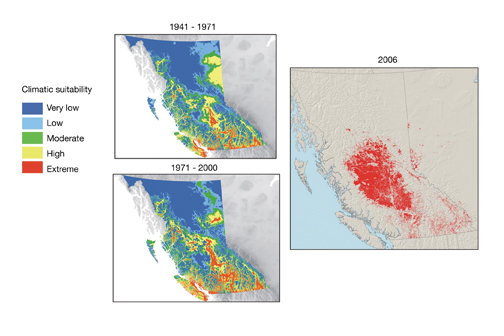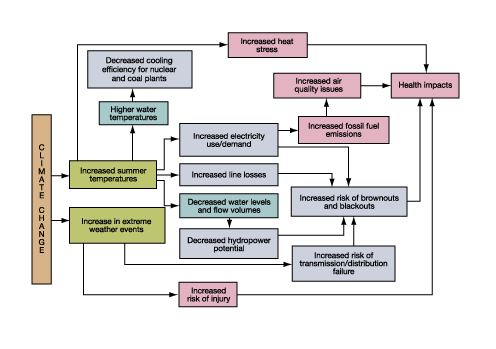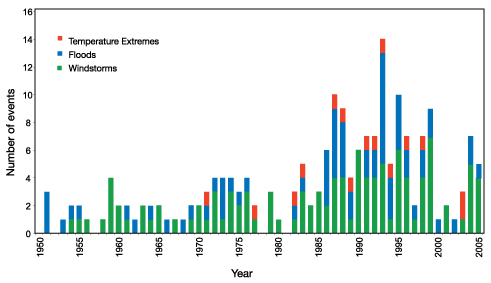IMPACTS
(Canada
in a Changing Climate)
The impacts of changing climate are already evident in every region
of Canada.
Impacts of changing climate on many physical and biological systems, such as
ice and snow cover, river, lake and sea levels, and plant and animal
distributions, are unequivocal (Table
SR-2) and have been documented in other recent climate change assessments
(Intergovernmental Panel on Climate Change 2001, 2007; Arctic Climate Impact
Assessment, 2005). In addition, increases in the occurrence of heat waves,
forest fires, storm-surge flooding, coastal erosion and other climate-related
hazards are consistent with observed climate trends. Many of these impacts
directly influence human systems. For example, decreases in the thickness and
duration of lake and river ice have significantly impacted the viability of
many winter road networks that provide access to remote communities and mine
sites in northern Canada (including the northern parts of many provinces),
while coastal erosion has impacted buildings and critical infrastructure, and
threatened cultural sites on all of Canada's marine coasts.
There is also strong evidence that climate change has been a
contributing factor to a number of other environmental, social and economic
issues. These include the unprecedented outbreak of mountain pine beetle in British Columbia, which
encompassed over 9.2 million ha of forest in 2007. Although fire
suppression and other historical factors have contributed to this outbreak, the
recent predominance of hot summers that favour beetle reproduction, and mild
winters that allow their offspring to survive, have been critical factors (Figure SR-2).
Since 1990 in parts of Atlantic Canada, sea lettuce has been spreading,
rendering estuaries less suitable for shellfish or finfish and less attractive
to residents and tourists. This spread has been related, in part, to
climate-driven reductions in freshwater inflow during summer

Figure
SR-2: Historical
distributions of climatically suitable habitats for the mountain pine beetle
(MPB) in western Canada
(adapted from Carroll et al., 2004). Areas with 'very low' suitability
are unsuitable for MPB, whereas 'extreme' areas are those considered
climatically optimal.
Table SR-2: Some
observed impacts of changing climate on physical and biological systems in Canada.
|

|
Glacier cover – mass and area; widespread
reductions with local variability
|
widespread retreat since late 1800s in western Canada, since 1920s in Arctic glaciers in BC are currently retreating at
rates unprecedented in the last 8000 years estimated loss of ice mass in Canadian Arctic
of 25 km3/a for period 1995–2000
|
|

|
Snow cover – reduced
annual extent and duration
|
|
|

|
Sea-, lake- and river-ice cover – reduced extent and duration
|
|
|

|
Permafrost conditions – warming and deepening of annual thaw layer
|
most significant warming in western Arctic 1°C increase in surface permafrost temperature
since 1990 in northern Quebec increase in summer thaw penetration in the
1990s
|
|

|
River and lake levels – changes in water levels and timing of peak flow
events |
decline in summer and fall runoff in Prairies,
leading to lower lake and river levels at those times trend towards earlier spring runoff
|
|

|
Plant phenology – events occurring earlier |
|
|

|
Plant productivity – lengthening growing seasons and increased productivity
|
|
|

|
Distribution of some animal species – northward or upslope shifts in terrestrial
ecosystems, shifts towards warmer thermal regimes in freshwater ecosystems
|
|
|

|
Coastal erosion – enhanced as a result of
decreased ice cover, sea-level rise, increased storminess, and non-climatic
factors
|
|
Climate change will exacerbate many current climate
risks, and present new risks and opportunities, with significant implications
for communities, industry, infrastructure and ecosystems.
Climate change is evidenced by changes in average conditions
as well as by changes in climate variability and extreme climate events. Many
of the most severe and costly impacts will be associated with projected
increases in the frequency and magnitude of extreme climate events and
associated natural disasters, including flooding due to high-intensity rainfall
and storm surges, ice and wind storms, heat waves and drought. An understanding
of future climate extremes is particularly important for the design and
maintenance of infrastructure, emergency management, and community health and
safety.
Gradual changes in average temperature, precipitation, and sea level also
affect community and ecosystem sustainability. Some of the most significant and
pervasive impacts in Canada
will be related to water resources. Water-stressed areas will expand due to
decreased runoff in many areas resulting from changes in precipitation and
increased evapotranspiration, while reduced water quality and quantity will be
experienced on a seasonal basis in every region of Canada. Increasing demands on water
resources for agriculture, energy production, communities and recreation will
have to be managed in consideration of ecosystem needs. In addition to
increasing the impacts already observed, changing climate will bring new risks
to some areas, such as the introduction of vector-borne diseases into areas
where climate conditions presently inhibit survival of the vector host.
Climate-related impacts on ecosystems will present new challenges to the
management of protected areas.
Climate change will also bring opportunities, including longer and warmer
growing seasons, which could increase productivity and allow cultivation of new
and potentially more profitable crops and tree species. Although global-scale
analysis suggests that climate change should benefit Canadian agriculture and
forests, studies in Canada
that factor in changes in disturbance regimes and more frequent drought are
less optimistic and stress the need for timely and effective adaptation.
Decreased sea-, river- and lake-ice cover permit longer shipping seasons,
although lower lake and river levels could have negative impacts on
transportation. Increased marine transport in the Arctic
would provide opportunities for economic growth, along with environmental and
security risks.
Impacts will be cumulative and frequently synergistic (Figure
SR-3). For example, increased frequency and magnitude of heat waves will
result in increased peak electricity demand for air conditioning, while
decreased runoff from mountain glaciers in western Canada
and lower water levels on the Great Lakes are
likely to reduce potential for hydroelectricity generation in these areas.
Combined with anticipated increases in demand for electricity related to
population and economic growth, changing climate could result in increased
numbers of black-out and brown-out events. The cumulative nature of impacts,
and associated cascading uncertainties, makes it likely that climate change
will produce 'surprises' — impacts related to the crossing of critical
thresholds that have not been anticipated. As is the case for all human and
managed natural systems, the magnitude of impacts can be reduced through
adaptation.

Figure
SR-3: Illustration of
the cumulative and synergistic impacts of climate change, using example of how
impacts on the energy sector can amplify the direct impacts of climate change
on human health.
Climate change impacts elsewhere in the world, and
adaptation measures taken to address these, will affect Canadian consumers, the
competitiveness of some Canadian industries, and Canadian activities related to
international development, aid and peace keeping.
Climate change impacts elsewhere in the world will affect supply-demand
dynamics and the competitive advantage of some Canadian industries. This will
influence the net economic costs of climate change in Canada. For
example, although forest productivity may increase in Canada, greater
productivity increases in other countries could result in lower
forestry-product prices on the global market and a reduced share of the market
for Canadian producers. For tourism, climate change may reduce the
attractiveness of some Canadian natural areas. When examined in a global
context, however, tourism in Canada
is expected to be positively impacted by climate change, as warmer temperatures
would make Canada a more
attractive destination for foreign tourists and encourage more Canadians to
forgo vacations to tropical locations due to less severe winters in Canada.
Climate changes elsewhere in the world
will also influence Canadian humanitarian and development activities. In
addition to commitments to assist developing countries in their efforts to
adapt to climate change, changing climate will increase the need for disaster
relief. Observed trends toward increases in the frequency of extreme climate
events (Figure
SR-4) are expected to continue in the future. Extreme events are also
expected to become more intense. Environmental stress and scarcity issues
(primarily related to food and water) caused by climate changes can exacerbate
political, social, economic, ethnic, religious or territorial conflicts,
leading to increased political instability and displacement of populations.

Figure SR-4: The number of climate related disasters, by
event, from 1950 to 2006 (Munich Reinsurance, 2006).














